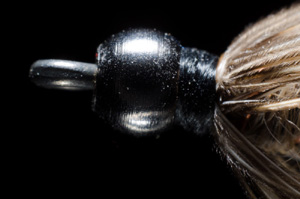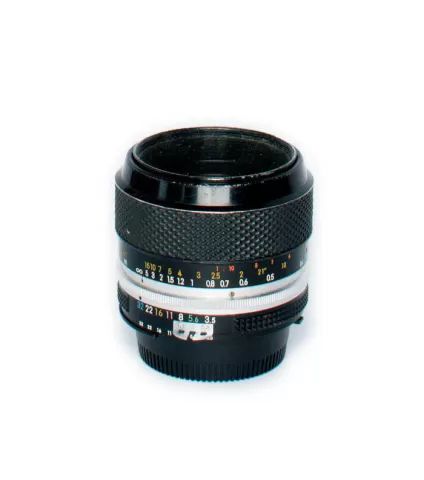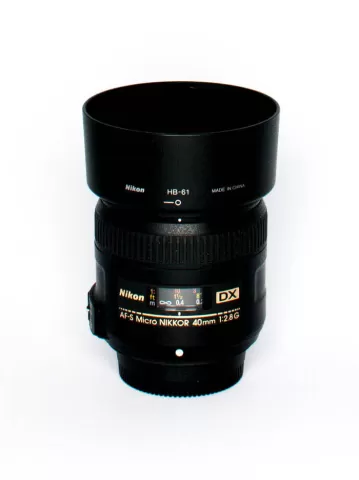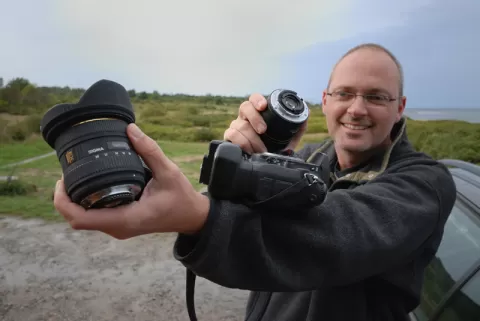Many Nikon macro bellows are known not to fit on modern SLR's, but I managed to make a very easy conversion to fit my Model III on all my Nikon bodies
I managed to lay my hands on a Nikon F Bellows Focusing Attachment Model III recently. The short name is Bellows PB-3. It looked perfectly new and the price was good, so I bought it.
I know that many call this particular model “the worst bellows Nikon ever made”, but I honestly don't care, because it works as intended and seems pretty sturdy to me. I have no complaints... now. Because when I returned after having purchased it I was somewhat befuddled at first.
The bellows didn't fit any of my digital SLR bodies – and I have four. A major letdown! Not that it was a lot of money, but I had looked forward to shooting some extreme closeups. The problem is that the rail under the bellows will interfere with the protruding handle on the left side of the camera (seen from the front). If you line up the dots on the mounts, the bellows can't be placed flush with the camera lens mount. So it simply can't be turned in place and locked. Well, after having tried all my bodies – D300s, D200, D5100 and even my old, trusty D40 – I had to conclude that it didn't work.
So I went into thinking mode and looked at the back of the bellows. It simply consists of a loose metal ring and a dull, black plate with a rectangular cutout – probably there to keep stray light under control.
They are both held in place by five small screws. I dug out a small screwdriver and a minute later, both the bayonet and the plate were loose, and a bit of logic told me that if I could rotate them clockwise, the rail would end in a position where it would clear the grip. It was done in seconds, and even though I could only get four of the five screws back in place – there simply is no hole for the last one – the back now sits firmly at an angle, which allows the bellows to be mounted on all my bodies, also the larger ones with a vertical grip.
The rail ends up in what might seem an awkward angle to the camera right and not under the lens as it's designed to, but that doesn't bother me much. The only major drawback is that the tripod screw hole in the rear part of the bellows is rendered useless, but I use the camera plates and brackets on my bodies anyway.
Using the bellows is a lot of fun and allows you to get real close.
I have four macro lenses, and the system works with all them. There is one catch, though, because the newest ones don't have an aperture ring, so there's no way of controlling the aperture. That has two implications: They always shoot at maximum aperture, which is f/36 for my 40mm f/2.8 and f/45 for the 85mm f/3.5 (yes, that's thirty six and forty five!), which might give the maximum depth of field, but isn't always optimal and requires a ton of light.
Secondly the image in the viewfinder (or on the LCD if you use live view) is also extremely dark bordering on pitch black, and requires a lot of light on the subject to allow you to see what is going on in your picture, compose and not least focus. It's not impossible, but it's difficult.

So I mainly use an ancient Micro Nikkor 55mm f/3.5 or a Sigma 90mm f/2.8 macro, which both stem from an era where lenses had aperture rings. These lenses allow me to open up, compose and focus and then stop down manually to any f-stop before shooting. The Nikon isn't very sharp, but can be used, while the Sigma is quite sharp.
I need to control stray light from the flash because both lenses are prone to flare and ghosting and there's usually no room for a lens hood because of the short distance to the subject. At the same time there's a real danger of the light from the flash hitting the front and inside of the lens because it's so close.
You can use most lenses on the bellows provided they fit physically on there. You can also use odd lenses like lenses from darkroom enlargers or other optical gizmos. A reverse ring allows you to use certain lenses reversed, and a wide angle lens can be turned into a great macro lens if it's reversed. But remember that all this means a lot of manual work and generally no control over the aperture.
Shooting with the bellows isn't easy, mostly because focusing is critical at the very high magnifications. The depth of field is extremely shallow, and you have to nail the basic focus point very precisely. Even at f/22 (or f/36 or f/45) you don't get much to work with. A sturdy focus rail is a good help and I usually use one for critical macro work.
You also need a lot of light. A flash is a must unless you have extreme amounts of constant light or a very, very stable setup for long exposures. I use an SB800 at somewhere between 1/32 and 1/4 power and place it very close to the subject (like a few inches away), and use a small home made softbox. You can also use ringflashes or specially made macro flashes, but a standard flash will do. All exposure is done manually since there is no way that the lens can tell the camera what is happening or vice versa.
But once the basic settings are there, you can really go close.
Is it useful?
For me, not really. I have shot with macro lenses for decades, and get more than close enough for my use, which is shooting done in nature of plants and animals and shooting done indoors of fishing flies and fly-tying.
Is it fun?
It sure is! Going close can reveal some textures and patterns unseen by the naked eye, and the bellows can sometimes show some surprising and beautiful details, which even my best macro lens can't get close enough to catch.











